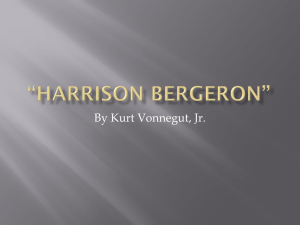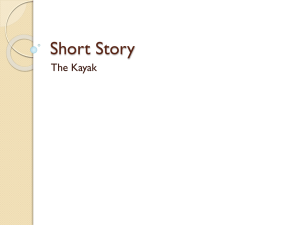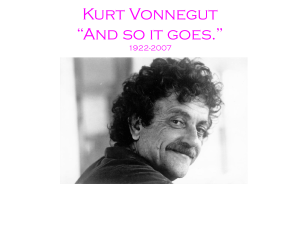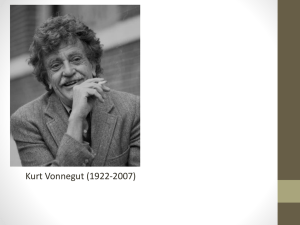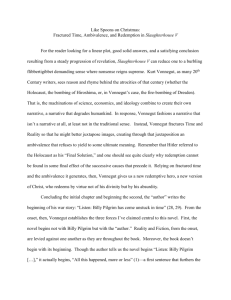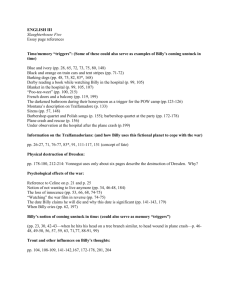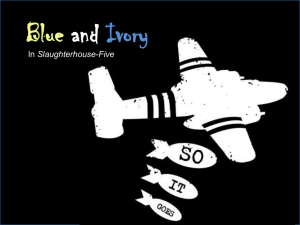Vonnegut`s Slaughterhouse Five - West Morris Central High School
advertisement
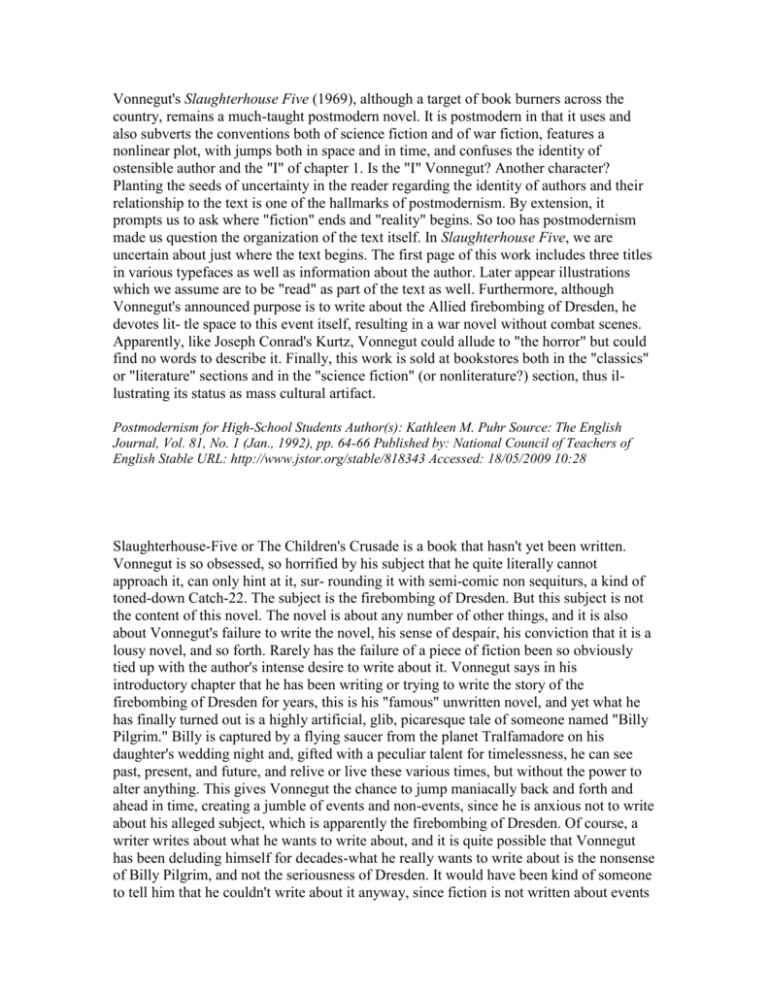
Vonnegut's Slaughterhouse Five (1969), although a target of book burners across the country, remains a much-taught postmodern novel. It is postmodern in that it uses and also subverts the conventions both of science fiction and of war fiction, features a nonlinear plot, with jumps both in space and in time, and confuses the identity of ostensible author and the "I" of chapter 1. Is the "I" Vonnegut? Another character? Planting the seeds of uncertainty in the reader regarding the identity of authors and their relationship to the text is one of the hallmarks of postmodernism. By extension, it prompts us to ask where "fiction" ends and "reality" begins. So too has postmodernism made us question the organization of the text itself. In Slaughterhouse Five, we are uncertain about just where the text begins. The first page of this work includes three titles in various typefaces as well as information about the author. Later appear illustrations which we assume are to be "read" as part of the text as well. Furthermore, although Vonnegut's announced purpose is to write about the Allied firebombing of Dresden, he devotes lit- tle space to this event itself, resulting in a war novel without combat scenes. Apparently, like Joseph Conrad's Kurtz, Vonnegut could allude to "the horror" but could find no words to describe it. Finally, this work is sold at bookstores both in the "classics" or "literature" sections and in the "science fiction" (or nonliterature?) section, thus illustrating its status as mass cultural artifact. Postmodernism for High-School Students Author(s): Kathleen M. Puhr Source: The English Journal, Vol. 81, No. 1 (Jan., 1992), pp. 64-66 Published by: National Council of Teachers of English Stable URL: http://www.jstor.org/stable/818343 Accessed: 18/05/2009 10:28 Slaughterhouse-Five or The Children's Crusade is a book that hasn't yet been written. Vonnegut is so obsessed, so horrified by his subject that he quite literally cannot approach it, can only hint at it, sur- rounding it with semi-comic non sequiturs, a kind of toned-down Catch-22. The subject is the firebombing of Dresden. But this subject is not the content of this novel. The novel is about any number of other things, and it is also about Vonnegut's failure to write the novel, his sense of despair, his conviction that it is a lousy novel, and so forth. Rarely has the failure of a piece of fiction been so obviously tied up with the author's intense desire to write about it. Vonnegut says in his introductory chapter that he has been writing or trying to write the story of the firebombing of Dresden for years, this is his "famous" unwritten novel, and yet what he has finally turned out is a highly artificial, glib, picaresque tale of someone named "Billy Pilgrim." Billy is captured by a flying saucer from the planet Tralfamadore on his daughter's wedding night and, gifted with a peculiar talent for timelessness, he can see past, present, and future, and relive or live these various times, but without the power to alter anything. This gives Vonnegut the chance to jump maniacally back and forth and ahead in time, creating a jumble of events and non-events, since he is anxious not to write about his alleged subject, which is apparently the firebombing of Dresden. Of course, a writer writes about what he wants to write about, and it is quite possible that Vonnegut has been deluding himself for decades-what he really wants to write about is the nonsense of Billy Pilgrim, and not the seriousness of Dresden. It would have been kind of someone to tell him that he couldn't write about it anyway, since fiction is not written about events but about people: Vonnegut has not created any people here, only bizarre cut-outs mouthing lines that are sometimes funny and some- times not. His grotesque scenes are unfelt because they are un- imagined. Author(s): Joyce Carol Oates Source: The Hudson Review, Vol. 22, No. 3 (Autumn, 1969), pp. 531-539 Published by: The Hudson Review, Inc. Stable URL: http://www.jstor.org/stable/3849448 Accessed: 18/05/2009 12:59 Kurt Vonnegut's Slaughterhouse-Five (1968) also thematizes the writing of history, this time of the Second World War, particularly the bombing of Dresden. It opens with a qualified truth claim: 'All this happened, more or less. The war parts, anyway, are pretty much true.'10 This parodies the eighteenth-century novelistic convention, as does the title page. Time is predictably unpredictable, even for the narrator, who experiences a conflict between subjective and objective time: 'The time would not pass [ . .] The second hand on my watch would twitch once, and a year would pass, and then it would twitch again' (p. 20). It is another framed narrative whose end is prefigured in its beginning as the narrator tells us that the story he is going to tell begins like this: Listen: Billy Pilgrim has come unstuck in time. It ends like this: Poo-tee-weet? (p. 22) And so it does. The narrator proceeds to relate the fantastic tale of Billy Pilgrim, war- time chaplain's assistant and time traveller. Aristotle's scenario, where 'nothing would be before or after anything else', is dramatized as the hero is abducted by benevolent Aliens, for whom all moments, past, present, and future, always have existed, always will exist. The Tralfamadorians can look at all the different moments [... ]. They can see how permanent all the moments are, and they can look at any moment that interests them. It is just an illusion we have here on Earth that one moment follows another one, like beads on a string. (p. 27) This picture of time has its origins in Einstein's general theory of relativity (I915), a radical revision of Newtonian physics, contemporaneous with modernism, which presents the universe in terms of a four-dimensional space-time continuum although it does not directly challenge the idea of linear time. Tralfamadorian plot construction is coherent with fourdimensional time; their novels are emphatically anti-Aristotelian and bear a singular resemblance both to Derrida's idea of writing and Melquiades' fictional technique in One Hundred rears of Solitude. They are laid out in clumps of symbols which are read 'all at once, not one after the other. There isn't any particular relationship between all the messages [...]. There is no beginning, no middle, no end, no suspense, no moral, no causes, no effects. What we love in our books are the depths of many marvelous moments seen all at one time' (p. 88). Conventional plot is considered in the initial framing chapter of Slaughterhouse-Five where the narrator discusses one version of the story which he has outlined in crayon on a roll of wallpaper: “A Brief Story of Postmodern Plot I used my daughter's crayons, a different color for each main character. One end of the wallpaper was the beginning of the story, and the other end was the end, and then there was all that middle part, which was the middle. And the blue line met the red line and then the yellow line, and the yellow line stopped because the character represented by the yellow line was dead. And so on.” (p. 5) The real plot of Slaughterhouse-Five is somewhere between the Aristotelian plot and Derrida's 'writing' or the narrator's plot diagram and a Tralfamad- orian novel. The postmodern plot and reading experience cannot match Derrida's ideal because the 'earthling' cannot read or write the scenes or symbols of the novel simultaneously. If we were to attempt to draw a real plot diagram of Slaughterhouse-Five in crayon, it would resemble coloured spaghetti. But although its jumps in time are more frequent and abrupt than those in either Midnight's Children or One Hundred rears ofSolitude, the prolepsis and analepsis is still 'realistically' motivated by Billy Pilgrim's travel backwards and forwards in time, which is itself naturalized by his abduction by the Tralfamadorians or, if you cannot stomach that, by his madness, caused by a bump on the head in an aeroplane crash. The narrator describes himself 'as a trafficker in climaxes and thrills and characterization and wonderful dialogue and suspense' (p. 5). Slaughterhouse-Five is another highly 'readable' novel where cause and effect still operate and even though the conclusion is written in the introduction the writer cannot dispense with suspense, because the reader does not know for sure whether or how that conclusion is reached until he reaches it in real time. According to John North, Stephen Hawking's deconstruction of the boundaries of time can be described in terms of a circular, self-contained universe which has no beginning or end. Possibly the replacement of linear time with circular or deconstructed time in postmodern theory and fiction is a manifestation of the fear of death, and these alternative narratives of time function to replace the religious narratives of immortality which have been discredited in a godless world. The Tralfamadorians have no such fear of death precisely because they can see the fourth dimension: 'When a Tralfamadorian sees a corpse, all he thinks is that the dead person is in a bad condition in that particular moment, but that the same person is just fine in plenty of other moments' (p. 27). Billy Pilgrim tries to spread the Tralfamad- orian gospel, at one point speaking at a radio conference on the death of the novel, at another reassuring a little boy he is fitting for glasses that his dead father is really alive in other moments. Paul Ricoeur suggests in Time and Narrative that it is through narrative that we humanize time and resolve the disjunction between our necessarily limited experience and the scientific idea of time. Both Hawking's theory and the fourth dimension as depicted in Vonnegut's novel are imaginative constructions to the extent that finity bounds human experience, but they are read in different ways: one as scientific exposition; the other for its entertainment value. Clearly, beginnings and endings have a special function in postmodern metafiction, marking the entrance and exit of the fictional world and its parallel time. There is a structural circularity in these novels which confounds linear time: the end of Midnight's Children returns to the present of the telling, a not unconventional plot device, but also foretells the future; the ending of One Hundred rears of Solitude is more complex as Aureliano reads his future in a historical document. The narrator of Slaughterhouse-Five is particularly taken with those songs whose last line repeats the first line 'And so on to infinity', like the story of Billy Pilgrim (p. 3). Derrida turns deconstruction on narrative time in 'The Law of Genre', an analysis of Blanchot's La Folie dujour, which includes in its final paragraphs its first line. Derrida reads this as a deconstruction of linear time: These first words mark a collapse that is [... ] unsuitable within a linear order of succession, within a spatial or temporal sequentiality, within an objectifiable topology or chronology. One sees [... .] reads the crumbling of an upper boundary. [... ] Suddenly, this upper or initial boundary, which is commonly called the first line of a book is forming a pocket inside the corpus. It is taking the form of an invagination through which the trait of the first line, the borderline, splits while remaining the same and traverses yet also bounds the corpus. 1 This symbolizes the deconstruction of narrative chronology. However, this kind of metafiction could just as easily be read as reinforcing the self- containment of the fictional world together with its particular chronology in an infinite 'loop'. A Brief Story of Postmodern Plot Author(s): Catherine Burgass Source: The Yearbook of English Studies, Vol. 30, Time and Narrative (2000), pp. 177-186 Published by: Maney Publishing on behalf of Modern Humanities Research Association Stable URL: http://www.jstor.org/stable/3509251 Accessed: 18/05/2009 13:10 KURT VONNEGUT, JR. Slaughterhouse-Five, or The Children's Crusade. On the night of February 13, 1945, British and American bombs began to fall on Dresden, theretofore an open city. In the fire storm and its aftermath more people died than in any other massacre in European history. Among the survivors was a very young American prisoner of war who lived because, as he says in the 1966 preface to Mother Night, We were in a cool meat locker under a slaughterhouse .... If we had gone above to take a look, we would have been turned into artifacts characteristic of fire storms: seeming pieces of charred firewood two or three feet long-ridiculously small human beings, or jumbo fried grasshoppers, if you will. . .. Everything was gone but the cellars where 135,000 Hansels and Gretels had been baked like gingerbread men. So we were put to work as corpse miners, breaking into shelters, bringing bodies out. And I got to see many German types of all ages as death had found them, usually with valuables in their laps. Sometimes relatives would come to watch us dig. They were interesting too. "Over the years," Vonnegut says in the first chapter of Slaughter- house-Five, "people have often asked me what I'm working on, and I've usually replied that the main thing was a book about Dresden." The reasons why the book was necessary and why it was so hard to write are fully evident in the book itself. In it the traumatic ex- periences which he speaks of in the preface to Mother Night are explored with courage, with great intellectual power and honesty, with gripping intensity, and with a sure sense of aesthetic form. The result is the most powerful novel I know of in the American literature of war. Slaughterhouse-Five is an artistic, as well as a personal, summa. The themes and ideas, even the persons and places, of the earlier work move through this latest novel into a rich and coherent whole. We can now see that earlier work in a new perspective. The early science fiction, for example, can now be seen as an attempt to discover new ways of explaining and justifying human history and Vonnegut's own experience. How can one justify, or even explain, what happened in Dresden? In the first chapter we are told that "there is nothing intelligent to say about a massacre." Yet one must somehow accept the realities of human history and of one's own experience. To deny them is insane and suicidal. This acceptance must begin with the acknowledgment of the fact of death. Early in the book Vonnegut juxtaposes the prayer of Alcoholics Anonymous with Celine's statement that "no art is possible without a dance with death." Death is one of those things we can't change, and part of wisdom is in learning that; but the quality of life is some- thing we can change, and we need to learn that too. Every life is a work of art whose values and assumptions must be tested constantly. Consider, for example, the theme of time in Slaughterhouse-Five. Billy Pilgrim, the protagonist, is "spastic in time," moving, without wishing to do so, throughout his chronological lifetime and even beyond (death is experienced simply as a purple color). The Tralfamadorians capture him, take him through a "time warp" to their distant planet, install him in a zoo with a luscious female Earthling, and watch them for months with fascination-all within an elapsed Earth time of a microsecond. Vonnegut is not just being clever; he is constantly testing the most basic assumptions which we all so confidently share. Time for Billy Pilgrim has become almost purely experiential. Free of his debt to his past and his future, he can build a more satisfying existence entirely in the present. Knowing he will die (and even when, where, and how, though not, of course, exactly why), he is free to live. The structure of Slaughterhouse-Five reflects this existential freedom. Seemingly disjointed or even, at times, inarticulate, the narrative technique reflects the experience which the book describes- an odyssey from horror and despair toward love and faith. Eventually, everything in the book falls into place-not just in a mechanical sense, but in the building of a rich and radiant vision of human life. In the process we pass through various stages of Vonnegut's own liberal education: in anthropology, journalism, sociology, public relations, World Federalism, and so on, none of which seems very rele- vant to the holocaust in Dresden. In anthropology, for instance, At that time, they were teaching that there was absolutely no difference between anybody. They may be teaching that still. Another thing they taught was that nobody was ridiculous or bad or disgusting. Shortly before my father died, he said to me, "You know-you never wrote a story with a villain in it." I told him that was one of the things I learned in college after the war. This is the tone of the book as a whole-not the shrill sarcasm of the revolutionary or the reactionary, but a gentle irony expressing a puzzled awareness of the contradictions between our experiences and our received interpretations of them. Most of it is directed against the liberal tradition which still dominates our culture. But the prose which conveys best Vonnegut's sense of outrage over Dresden is the "objective" excerpts he quotes from memoirs and history books. The subtitle fulfills a promise to a woman who had assumed that the great Dresden novel would be the standard view of war as a supreme test of human character. The subtitle is appropriate because the book is Vonnegut's own crusade for the children of the world-- and also because the fire storm in Dresden, like the original Children's Crusade, was the product of extreme idealism and extreme corruption. Anyone who has watched a World War II movie on the late show knows the feeling: could anyone ever have been so innocent? and so guilty? Billy Pilgrim "stared into the patina of the corporal's boots, saw Adam and Eve in the golden depths. They were naked. They were so innocent, so vulnerable, so eager to behave decently. Billy Pilgrim loved them." So it goes. What can Billy Pilgrim do to change the world? Not much really: "Among the things Billy Pilgrim could not change were the past, the present, and the future." He can refuse to kill. He can care about people, and try to comfort them (his "insane" ideas about Tralfamadore, eternal life, etc. spill out for the first time when he tries to comfort a boy whose father has died in Viet Nam). Love never dies. It radiates far beyond the finite bodies in which it finds incarnation, and is experienced again and again, and anywhere. Truth, charity, affection, openness, compassion: this is the love which Vonnegut writes about, and which is so convincing because it shines forth from the darkest knowledge of horror and despair. Trends in Recent American Fiction Author(s): Howard M. Harper, Jr. Source: Contemporary Literature, Vol. 12, No. 2 (Spring, 1971), pp. 204-229 Published by: University of Wisconsin Press Stable URL: http://www.jstor.org/stable/1207737 Accessed: 18/05/2009 13:15 Thus much of Vonnegut's Slaughterhouse-Five, for example, centers on the impossibility of distinguishing between facts and fictions. The tension between Billy Pilgrim's trips to Tralfamidore as real and as fantasies is a precise expression of the general blurring of the distinction between fact and fiction or reality and fantasy that Vonnegut is centrally concerned with in this book, as elsewhere. Given our epistemological situation today, in which the observer is implicated in what he observes, Vonnegut asks how we can ever see reality in any objective sense, how we can know anything but a personal or projected vision, a fantasy. The funny sequence when the American prisoners are greeted by the British in the German prison camp is an example of Vonnegut's point that we see the world as a fiction we project on it. The British have a fantasy of what the Americans will be like and they insist on sticking to it. They are disappointed at the condition, costume, and smell of the Americans. They want to involve them in playing a fiction, a game of musical comedy, at the most inappropriate time, just when the Americans have come from the grueling and almost annihilating experience of being transported to the prison in over-crowded, unsanitary cattle cars. But everybody in the novel is playing games in one way or another. The Germans like the British because they make war seem sport. The Americans, on the other hand, are always either living some idyllic fantasy, like Edgar Derby, who thinks he is a scout master, or some harsh fantasy, as, for example, is Paul Lazarro, who lives a kind of gangster-movie existence. Billy sees that others take their fictions to be reality. But because he cannot find any basis for distinguishing between the value of one fantasy and another, or for communicating that difference, he accepts all views. The best he can do when he sees the suffering and death resulting from some view is to cry. But Billy, too, is attracted by playing and fantasizing. The major action of the novel concerns Billy's inability to control his own often contradictory fantasies. He drifts among making trips to Tralfamidore, being president of the Local Lion's Club, being a prisoner of war, and trying to convert earthlings to a Tralfamidorian view of experience. Each of these fantasies is a role for Billy, a game he plays to avoid one of his other roles. By making game-playing the action of the novel, Vonnegut can present the wildest inventions as forms of meaningful action. In so doing, he shifts the focus of his action from social criticism to inventiveness itself. For while Vonnegut's concentration on game-playing satirizes the inadequate visions of the British prisoners and others who act as if life were a fairy tale or a Hollywood movie, and parodies formula living and formula writing in general, his primary concern is with celebrating invention itself, man's ability to play even in the face of a meaningless universe. His aim is positive rather than negative. We see this, for example, in the prison camp sequence, where Vonnegut's exuberant imagination, his sheer delight in playing with an outrageous situation, is evident. The assemblage of images - soldiers singing a comic opera greeting, a musical version of "Cinderella," the inanity of the British soldier's advice to Billy about the importance of daily bowel movements while Billy is fainting from hunger and fatigue, even Billy's ill-fated acquisition of the silver boots - suggests an overflow of playful high spirits rather than a concentration on social criticism. Many other sequences in the novel also suggest a dominant element of playfulness, most notably the death of Billy's wife and his affair with Montana Wildhack. The alternation between Billy's earthly miseries and the Tralfamidorian paradise of Montana's bosom is also playful, as is Billy's speech to the Lion's Club intercut with Edgar Derby's speech to the prisoners. In all of these sequences we are attracted not by the social criticism, for Vonnegut's critical points in each case are obvious, but by the imaginative fun Vonnegut invents for each episode. Not least is the fun of Vonnegut's style itself; he seems almost to be daring himself to discover how many disjunctive elements he can put in a single sentence, each connected by "and," without breaking the sentence itself into fragments. have come from the grueling and almost annihilating experience of being transported to the prison in over-crowded, unsanitary cattle cars. But everybody in the novel is playing games in one way or another. The Germans like the British because they make war seem sport. The Americans, on the other hand, are always either living some idyllic fantasy, like Edgar Derby, who thinks he is a scout master, or some harsh fantasy, as, for example, is Paul Lazarro, who lives a kind of gangster-movie existence. Billy sees that others take their fictions to be reality. But because he cannot find any basis for distinguishing between the value of one fantasy and another, or for communicating that difference, he accepts all views. The best he can do when he sees the suffering and death resulting from some view is to cry. But Billy, too, is attracted by playing and fantasizing. The major action of the novel concerns Billy's inability to control his own often contradictory fantasies. He drifts among making trips to Tralfamidore, being president of the Local Lion's Club, being a prisoner of war, and trying to convert earthlings to a Tralfamidorian view of experience. Each of these fantasies is a role for Billy, a game he plays to avoid one of his other roles. By making gameplaying the action of the novel, Vonnegut can present the wildest inventions as forms of meaningful action. In so doing, he shifts the focus of his action from social criticism to inventiveness itself. For while Vonnegut's concentration on game-playing satirizes the inadequate visions of the British prisoners and others who act as if life were a fairy tale or a Hollywood movie, and parodies formula living and formula writing in general, his primary concern is with celebrating invention itself, man's ability to play even in the face of a meaningless universe. His aim is positive rather than negative. We see this, for example, in the prison camp sequence, where Vonnegut's exuberant imagination, his sheer delight in playing with an outrageous situation, is evident. The assemblage of images - soldiers singing a comic opera greeting, a musical version of "Cinderella," the inanity of the British soldier's advice to Billy about the importance of daily bowel movements while Billy is fainting from hunger and fatigue, even Billy's ill-fated acquisition of the silver boots - suggests an overflow of playful high spirits rather than a concentration on social criticism. Many other sequences in the novel also suggest a dominant element of playfulness, most notably the death of Billy's wife and his affair with Montana Wildhack. The alternation between Billy's earthly miseries and the Tralfamidorian paradise of Montana's bosom is also playful, as is Billy's speech to the Lion's Club intercut with Edgar Derby's speech to the prisoners. In all of these sequences we are attracted not by the social criticism, for Vonnegut's critical points in each case are obvious, but by the imaginative fun Vonnegut invents for each episode. Not least is the fun of Vonnegut's style itself; he seems almost to be daring himself to discover how many disjunctive elements he can put in a single sentence, each connected by "and," without breaking the sentence itself into fragments. Satire as Rhetorical Play Author(s): Harriet Deer and Irving Deer Source: boundary 2, Vol. 5, No. 3 (Spring, 1977), pp. 711-722 Published by: Duke University Press Stable URL: http://www.jstor.org/stable/302551 Accessed: 18/05/2009 13:22
